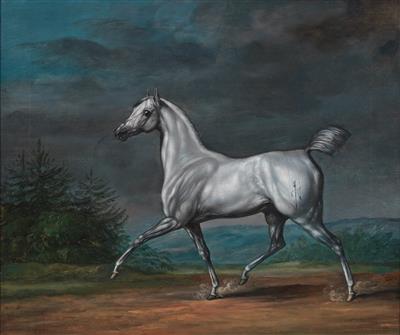Künstler 1. Hälfte 19. Jahrhundert

An Arab Stallion belonging to the Friedrich-Wilhelm Stud in Neustadt an der Dosse, oil on canvas, 45.5 x 54 cm, framed, (Rei)
We are grateful to Christopher Wentworth-Stanley for his assistance in cataloguing this work.
The Friedrich-Wilhelm stud in Neustadt an der Dosse enjoys a long tradition which began at the end of the 17th century under the auspices of the Elector of Brandenburg, before advancing to become a Royal Prussian institution. Originally breeding mules in Neustadt for the army, a concept favoured by Frederick Wilhelm I of Prussia and his son, Frederick the Great, it was their successor, Frederick Wilhelm II, who adopted the goal of breeding “noble horses”, an activity rare in Prussia at that time. Consequently, in 1788 he ordered the Prussian studs to be reorganised, and a new stud in Neustadt an der Dosse to be established. His goal was to use first-class stallions to refine the formerly unattractive breeding of horses for agricultural use. On July 31, 1787 the king signed in the relevant law “for the benefit of the state”, and ordered a breeding facility, the “Frederick Wilhelm stud”, to be erected on land formerly housing the mule stud. 600 acres of meadows and pastures were transferred to the stud, with stables for 60 mares and 100 stallions constructed soon afterwards.
In 1789 thirteen Arab stallions were brought to the stud to improve the local equine stock, with the intention of combining the size of the English thoroughbreds with the noble characteristics of the Arabs, namely beauty and performance. The stud was evacuated in 1806 during the chaos ensuring in the Napoleonic-Prussian war. It remained dissolved until 1810, to be re-established afterwards with a great number of mares and stallions. In response to the growing fashion for horseracing, the Neustadt stud also strongly focused on breeding in the English manner. The training institute was built in 1843, English trainers were imported, and a race course laid out which hosted races annually until 1857.
The characteristic branding mark of an arrow and snake was also specified by royal command. Yearlings were all branded with this symbol of speed, intelligence and agility. (Carl Bräuer, Die Gestüte des In- und Auslandes, Dresden 1901, p.6-7)
Expert: Mag. Dimitra Reimüller
 Mag. Dimitra Reimüller
Mag. Dimitra Reimüller
+43-1-515 60-355
19c.paintings@dorotheum.at
21.04.2016 - 18:00
- Dosažená cena: **
-
EUR 7.500,-
- Odhadní cena:
-
EUR 6.000,- do EUR 8.000,-
Künstler 1. Hälfte 19. Jahrhundert
An Arab Stallion belonging to the Friedrich-Wilhelm Stud in Neustadt an der Dosse, oil on canvas, 45.5 x 54 cm, framed, (Rei)
We are grateful to Christopher Wentworth-Stanley for his assistance in cataloguing this work.
The Friedrich-Wilhelm stud in Neustadt an der Dosse enjoys a long tradition which began at the end of the 17th century under the auspices of the Elector of Brandenburg, before advancing to become a Royal Prussian institution. Originally breeding mules in Neustadt for the army, a concept favoured by Frederick Wilhelm I of Prussia and his son, Frederick the Great, it was their successor, Frederick Wilhelm II, who adopted the goal of breeding “noble horses”, an activity rare in Prussia at that time. Consequently, in 1788 he ordered the Prussian studs to be reorganised, and a new stud in Neustadt an der Dosse to be established. His goal was to use first-class stallions to refine the formerly unattractive breeding of horses for agricultural use. On July 31, 1787 the king signed in the relevant law “for the benefit of the state”, and ordered a breeding facility, the “Frederick Wilhelm stud”, to be erected on land formerly housing the mule stud. 600 acres of meadows and pastures were transferred to the stud, with stables for 60 mares and 100 stallions constructed soon afterwards.
In 1789 thirteen Arab stallions were brought to the stud to improve the local equine stock, with the intention of combining the size of the English thoroughbreds with the noble characteristics of the Arabs, namely beauty and performance. The stud was evacuated in 1806 during the chaos ensuring in the Napoleonic-Prussian war. It remained dissolved until 1810, to be re-established afterwards with a great number of mares and stallions. In response to the growing fashion for horseracing, the Neustadt stud also strongly focused on breeding in the English manner. The training institute was built in 1843, English trainers were imported, and a race course laid out which hosted races annually until 1857.
The characteristic branding mark of an arrow and snake was also specified by royal command. Yearlings were all branded with this symbol of speed, intelligence and agility. (Carl Bräuer, Die Gestüte des In- und Auslandes, Dresden 1901, p.6-7)
Expert: Mag. Dimitra Reimüller
 Mag. Dimitra Reimüller
Mag. Dimitra Reimüller
+43-1-515 60-355
19c.paintings@dorotheum.at
|
Horká linka kupujících
Po-Pá: 10.00 - 17.00
kundendienst@dorotheum.at +43 1 515 60 200 |
| Aukce: | Obrazy 19. století |
| Typ aukce: | Salónní aukce |
| Datum: | 21.04.2016 - 18:00 |
| Místo konání aukce: | Wien | Palais Dorotheum |
| Prohlídka: | 09.04. - 21.04.2016 |
** Kupní cena vč. poplatku kupujícího a DPH
Není již možné podávat příkazy ke koupi přes internet. Aukce se právě připravuje resp. byla již uskutečněna.
